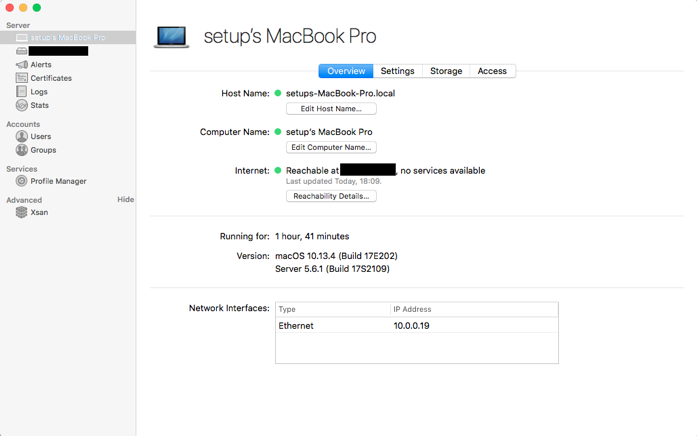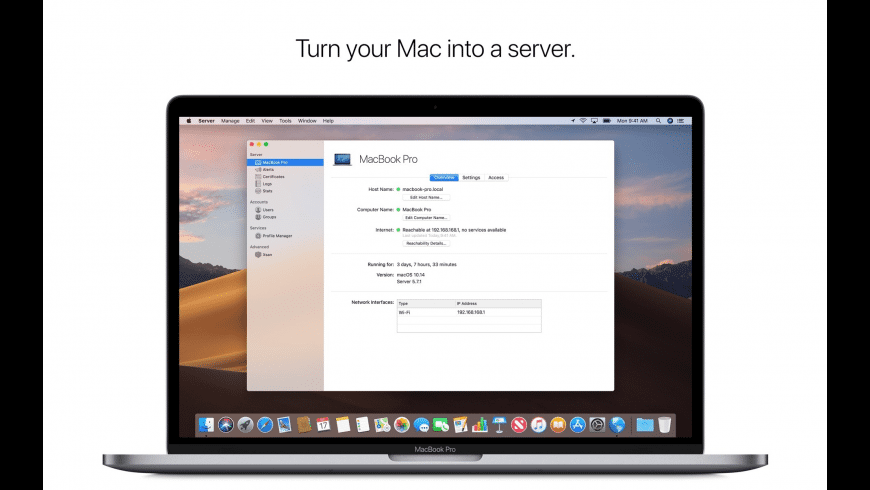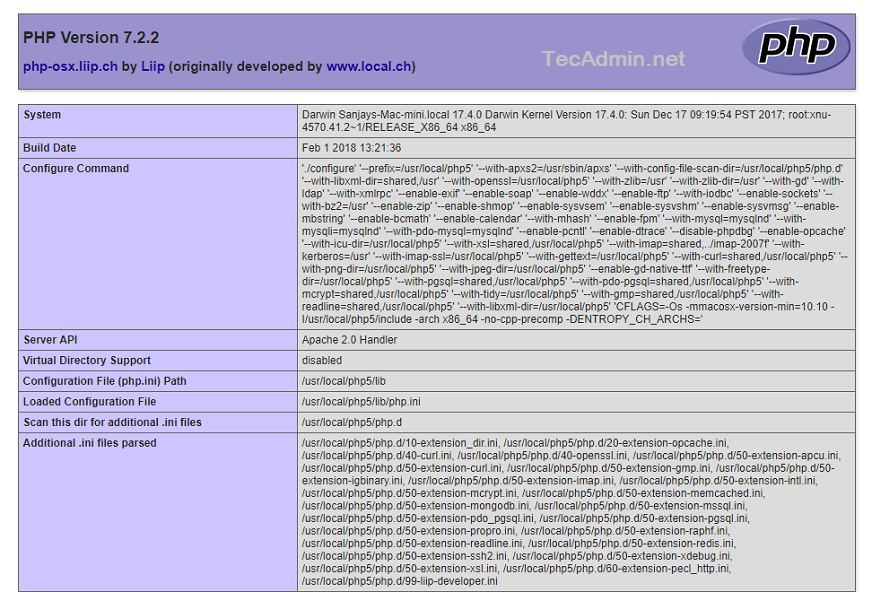Macos Server 5.6.3
MacOS Server 5.6.3 includes multiple services and runs on macOS 10.13 High Sierra. It can be installed on 10.14.0 but you only get the very limited feature set which is the same as 5.7.x. It will not run on macOS 10.14.1-10.14.6 - if you install it on these versions macOS will require you to upgrade to 5.7.x. Profile Manager help Enable mobile device management Reset Profile Manager Ports used by Profile Manager in macOS Server Resolve issues with Profile Manager in macOS Server. Xsan is a powerful and scalable solution for storage and consolidation in macOS. Use the resources below to learn about setup options, network management. How To Obtain/Purchase/Download macOS Server for macOS 10.13 High Sierra WARNING: As of September 2018 Apple has gutted macOS Server and removed most/all of the useful Server features! MacOS Server 5.4-5.6.3 was replaced with macOS Server 5.7.1 on the 28th September 2018. However, you can still purchase/download macOS Server 5.6.3 from the Mac. Interesting Thread that is helpful. However, I suppose I am among some that are attempting to keep the Apple server app version 5.6.3 alive a few more years while it still has useful features in it (newer versions are stripped of functionality).
 Article ID = 201
Article ID = 201Article Title = macOS Server 5.6.3-5.7.x Frequently Asked Questions FAQ
Article Author(s) = Graham Needham (BH)
Article Created On = 24th September 2018
Article Last Updated = 9th October 2019
Article URL = https://www.macstrategy.com/article.php?201
Article Brief Description:
Frequently Asked Questions about macOS Server 5.6.3-5.7.x
macOS Server 5.6.3-5.7.x Frequently Asked Questions
WARNING: Apple has gutted macOS Server and removed most/all of the useful Server features!Q. When will macOS Server 5.6.3 be available?
A. macOS Server 5.6.3 was released on the 24th September 2018. macOS Server 5.7.1 was released on the 28th September 2018. They were both replaced with macOS Server 5.9 on the 8th October 2019. However, you can still purchase/download it from the Mac App StoreQ. What's the difference between Server 5.6.3 and 5.7.x?
A. macOS Server 5.6.3 includes multiple services and runs on macOS 10.13 High Sierra. It can be installed on 10.14.0 but you only get the very limited feature set which is the same as 5.7.x. It will not run on macOS 10.14.1-10.14.6 - if you install it on these versions macOS will require you to upgrade to 5.7.x.A. macOS Server 5.7.x includes only a few services, see below, and requires macOS 10.14.1-10.14-6.
Q. How much does macOS Server 5.7.x cost?
A. £19.99.Q. What does macOS Server 5.7.x do if Apple has gutted it?
A. Not a lot! macOS Server 5.7.x's features are:- Profile Manager
- Open Directory
- Xsan
- DHCP - service is still included but there is no Graphical User Interface (GUI)
- Firewall - pf firewall service is still included but there is no Graphical User Interface (GUI)
- Websites (Apache) - service is still included but there is no Graphical User Interface (GUI)
- Net Boot / Net Install - services are still included but there is no Graphical User Interface (GUI)
- File Sharing - replaced with service in macOS client
- Time Machine server - replaced with service in macOS client - network Time Machine backups supported over SMB only
- Caching - replaced with Content Caching service in macOS client
- FTP
- Server Docs
- DNS
- VPN
- Mail Server
- Calendar
- Wiki
- Contacts
- Messages
- RADIUS
- Airport Management
- Software Update
- Xcode (replaced with Xcode for macOS client)
- NAT
- MySQL
- WebMail
- MailMan (can be built and installed manually)
- Auto Vacation Replies
- Podcast Producer
- Podcast Publisher
- Server Status Dashboard widget
- Management of Non-macOS Server 5.7.x Servers
- Mobile Access
- Tomcat
- Axis
- QuickTime Streaming Server (QTSS)
Q. If Apple has removed services is there any way to still run them?
A. Yes. See this Apple support article for links to third party/open source alternatives.Q. What alternatives/GUI applications do you recommend?
A. We're testing various solutions and will update this article over time. Not all alternatives are free. We recommend:- FTP
- Server Docs
- DHCP
- DNS
- VPN
- Firewall
- Mail Server
- Mailing Lists -->MailMan can be built and installed manually
- WebMail
- Auto Vacation Replies
- Calendar
- Wiki
- Websites
- Contacts
- Net Boot/Net Install
- Messages
- RADIUS
- MySQL - can be installed manually
- (Axis) Print Server
- Tomcat - can be installed manually

Q. How can I buy/obtain macOS Server 5.7.x?
A. See our article on how to purchase/download it from the Mac App Store.Q. What Macs can I install macOS Server 5.7.x on?
A. macOS Server 5.7.x requires a Mac that can run macOS 10.14 MojaveNOTE: You will need an Apple ID to be able to download and install macOS 10.14 Mojave and then purchase macOS Server 5.7.x from the Mac App Store.

Q. How can I check what specifications my computer has?
Q. Which Mac do I have?
A. You can check 'Processor', 'Memory' and macOS/OS X/Mac OS X 'Version' by going to Apple menu > About This Mac > Overview tab if necessary (hint - clicking on the version number will give you the 'build' number).A. To check your Mac's 'Model Name' go to Apple menu > About This Mac > Overview tab if necessary > check for the computer name in the top line e.g. 'MacBook Pro' (this can only be checked with OS X 10.7 or later)
A. To check your Mac's model date version go to Apple menu > About This Mac > Overview tab if necessary > check the details after the Model Name e.g. 'Early 2015' (this can only be checked with OS X 10.7 or later) - to be more specific and exact you can check what 'Model Identifier' your Mac has by:
- If you are running Mac OS X 10.6 or earlier go to Apple menu > About This Mac > click the 'More Info…' button > (the System Profiler application will open) select 'Hardware' in the top left > check what it says for 'Model Identifier' on the right.
- If you are running OS X 10.7 or OS X 10.8 go to Apple menu > About This Mac > click the 'More Info…' button > (the System Information application will open) select 'Hardware' in the top left > check what it says for 'Model Identifier' on the right under 'Hardware Overview'.
- If you are running OS X 10.9 or later go to Apple menu > About This Mac > click the 'Overview' tab in the top left > click the 'System Report…' button > (the System Information application will open) select 'Hardware' in the top left > check what it says for 'Model Identifier' on the right under 'Hardware Overview'.
- If you are running Mac OS X 10.6 or earlier go to Apple menu > About This Mac > click the 'More Info…' button > (the System Profiler application will open) select 'Graphics/Displays' under 'Hardware' in the top left (click the triangle down if necessary) > click on the 'Video Card' on the right to see the technical information below.
- If you are running OS X 10.7 or OS X 10.8 go to Apple menu > About This Mac > click the 'More Info…' button > (the System Information application will open) select 'Graphics/Displays' under 'Hardware' in the top left (click the triangle down if necessary) > click on the 'Video Card' on the right to see the technical information below.
- If you are running OS X 10.9 or later go to Apple menu > About This Mac > click the 'Overview' tab in the top left > click the 'System Report…' button > (the System Information application will open) select 'Graphics/Displays' under 'Hardware' in the top left (click the triangle down if necessary) > click on the 'Video Card' on the right to see the technical information below. With OS X 10.11 or later here you will also find whether your GPU supports 'Metal'.
Q. I have a powerful Mac Pro / Xserve or a Mac with an early 'Core 2 Duo' which is a good Intel processor. Why can't I run macOS Server 5.7.x?
A. macOS Server 5.7.x requires a Mac with macOS 10.14 Mojave installed on it so you can only run macOS Server 5.7.x on a Mac that supports macOS 10.14 Mojave.Q. If there is no physical macOS or Server discs and I install macOS + macOS Server 5.7.x but run into trouble what can I do?
 A. You have several options:
A. You have several options:- When macOS 10.14 Mojave + macOS Server 5.7.x is installed it creates a special bootable emergency 'recovery' area on your hard disk.You can Use the macOS 'Recovery HD' to repair your hard disk and/or reinstall macOS + macOS Server 5.7.x (internet connection required).
- If you have created an emergency external USB recovery drive using Apple's Recovery Disk Assistant you can use it to boot your computer from and repair your hard disk and/or reinstall macOS + macOS Server 5.7.x (internet connection required).
- If you have a Time Machine backup disk it may have an macOS 'Recovery HD' partition on it which you can use to repair your hard disk and/or reinstall macOS + macOS Server 5.7.x (internet connection required).
- If you have created an External Installation Device you can use it to boot your computer and repair your hard disk and/or reinstall macOS + macOS Server 5.7.x.
- If you have created an Emergency Boot Drive for macOS you can use it to boot your computer and repair your hard disk.
Q. What should I do to prepare for macOS Server 5.7.x?
A. See this article.Article Keywords: macOS 1014 Mojave Server 5.6.3 5.7.1 Frequently Asked Questions FAQ OSXserver56 OSXserver57
Macos Server 5.6.3 Free
This article is © MacStrategy » a trading name of Burning Helix. As an Amazon Associate, employee's of MacStrategy's holding company (Burning Helix sro) may earn from qualifying purchases. Apple, the Apple logo, and Mac are trademarks of Apple Inc., registered in the U.S. and other countries. App Store is a service mark of Apple Inc.
All proceeds go directly to MacStrategy / Burning Helix to help fund this web site.
All proceeds go directly to MacStrategy / Burning Helix to help fund this web site.
Go to this
web page
to donate to us.
MySQL Enterprise Thread Pool comprises these elements:
Macos Server 5.6.3 Download
A plugin library file implements a plugin for the thread pool code as well as several associated monitoring tables that provide information about thread pool operation:
As of MySQL 8.0.14, the monitoring tables are Performance Schema tables; see Section 27.12.16, “Performance Schema Thread Pool Tables”.
Prior to MySQL 8.0.14, the monitoring tables are
INFORMATION_SCHEMAtables; see Section 26.52, “INFORMATION_SCHEMA Thread Pool Tables”.The
INFORMATION_SCHEMAtables now are deprecated; expect them to be removed in a future version of MySQL. Applications should transition away from theINFORMATION_SCHEMAtables to the Performance Schema tables. For example, if an application uses this query:The application should use this query instead:
If you do not load all the monitoring tables, some or all MySQL Enterprise Monitor thread pool graphs may be empty.
For a detailed description of how the thread pool works, see Section 5.6.3.3, “Thread Pool Operation”.
Several system variables are related to the thread pool. The
thread_handlingsystem variable has a value ofloaded-dynamicallywhen the server successfully loads the thread pool plugin.The other related system variables are implemented by the thread pool plugin and are not available unless it is enabled. For information about using these variables, see Section 5.6.3.3, “Thread Pool Operation”, and Section 5.6.3.4, “Thread Pool Tuning”.
The Performance Schema has instruments that expose information about the thread pool and may be used to investigate operational performance. To identify them, use this query:
For more information, see Chapter 27, MySQL Performance Schema.